Assignment on Social Media PDF
VerifiedAdded on 2021/06/17
|15
|5158
|1097
AI Summary
Contribute Materials
Your contribution can guide someone’s learning journey. Share your
documents today.
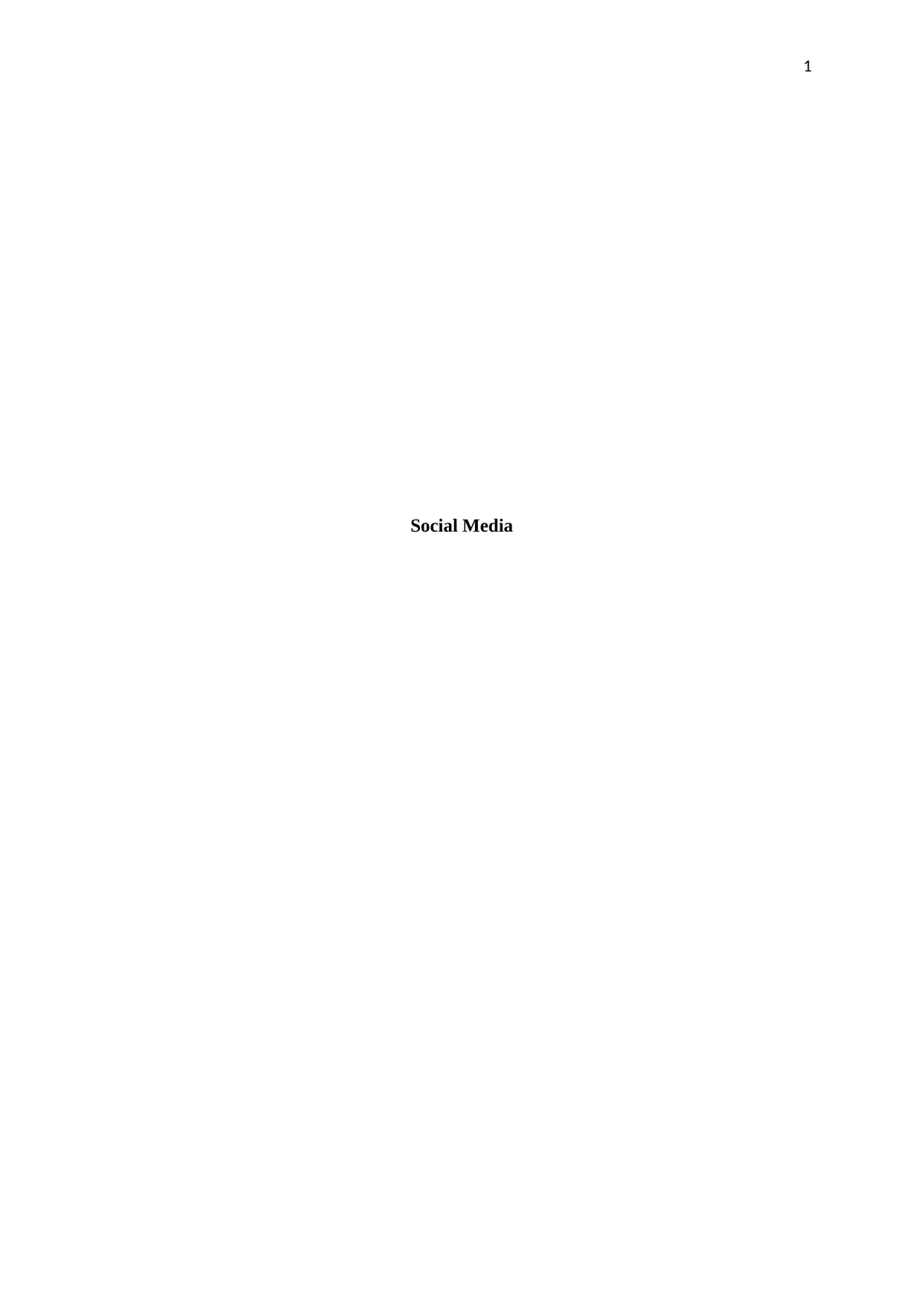
1
Social Media
Social Media
Secure Best Marks with AI Grader
Need help grading? Try our AI Grader for instant feedback on your assignments.
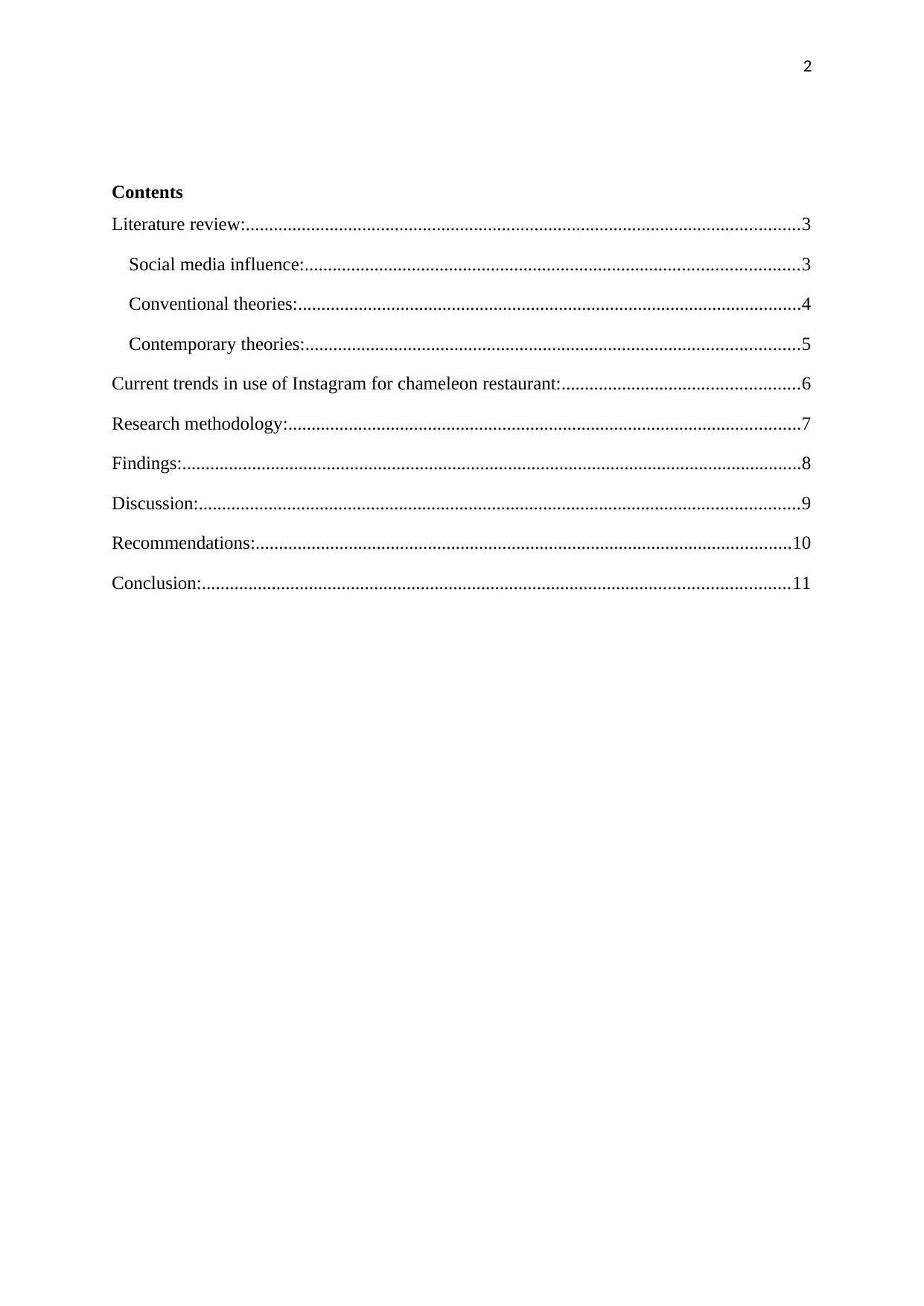
2
Contents
Literature review:.......................................................................................................................3
Social media influence:..........................................................................................................3
Conventional theories:............................................................................................................4
Contemporary theories:..........................................................................................................5
Current trends in use of Instagram for chameleon restaurant:...................................................6
Research methodology:..............................................................................................................7
Findings:.....................................................................................................................................8
Discussion:.................................................................................................................................9
Recommendations:...................................................................................................................10
Conclusion:..............................................................................................................................11
Contents
Literature review:.......................................................................................................................3
Social media influence:..........................................................................................................3
Conventional theories:............................................................................................................4
Contemporary theories:..........................................................................................................5
Current trends in use of Instagram for chameleon restaurant:...................................................6
Research methodology:..............................................................................................................7
Findings:.....................................................................................................................................8
Discussion:.................................................................................................................................9
Recommendations:...................................................................................................................10
Conclusion:..............................................................................................................................11
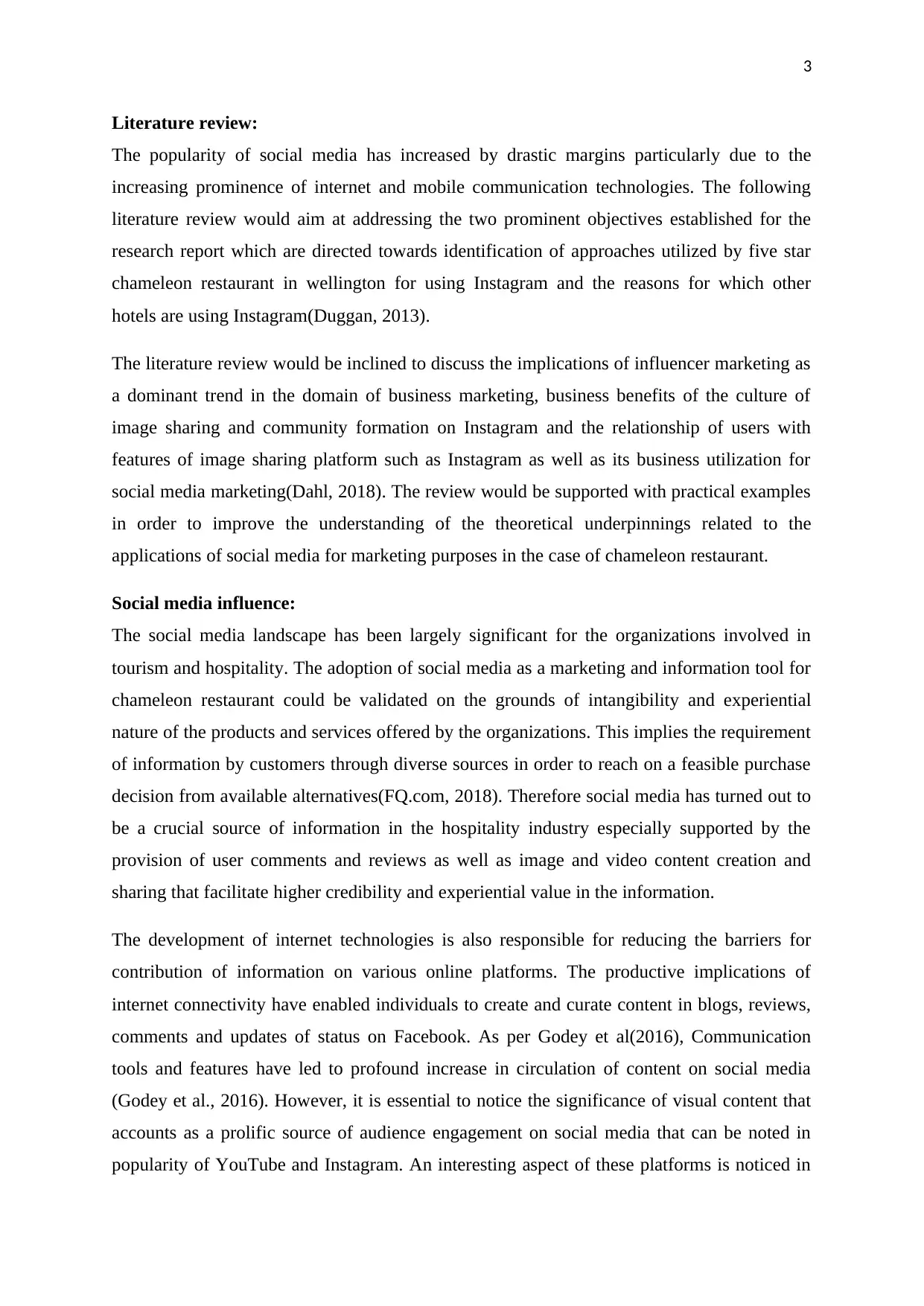
3
Literature review:
The popularity of social media has increased by drastic margins particularly due to the
increasing prominence of internet and mobile communication technologies. The following
literature review would aim at addressing the two prominent objectives established for the
research report which are directed towards identification of approaches utilized by five star
chameleon restaurant in wellington for using Instagram and the reasons for which other
hotels are using Instagram(Duggan, 2013).
The literature review would be inclined to discuss the implications of influencer marketing as
a dominant trend in the domain of business marketing, business benefits of the culture of
image sharing and community formation on Instagram and the relationship of users with
features of image sharing platform such as Instagram as well as its business utilization for
social media marketing(Dahl, 2018). The review would be supported with practical examples
in order to improve the understanding of the theoretical underpinnings related to the
applications of social media for marketing purposes in the case of chameleon restaurant.
Social media influence:
The social media landscape has been largely significant for the organizations involved in
tourism and hospitality. The adoption of social media as a marketing and information tool for
chameleon restaurant could be validated on the grounds of intangibility and experiential
nature of the products and services offered by the organizations. This implies the requirement
of information by customers through diverse sources in order to reach on a feasible purchase
decision from available alternatives(FQ.com, 2018). Therefore social media has turned out to
be a crucial source of information in the hospitality industry especially supported by the
provision of user comments and reviews as well as image and video content creation and
sharing that facilitate higher credibility and experiential value in the information.
The development of internet technologies is also responsible for reducing the barriers for
contribution of information on various online platforms. The productive implications of
internet connectivity have enabled individuals to create and curate content in blogs, reviews,
comments and updates of status on Facebook. As per Godey et al(2016), Communication
tools and features have led to profound increase in circulation of content on social media
(Godey et al., 2016). However, it is essential to notice the significance of visual content that
accounts as a prolific source of audience engagement on social media that can be noted in
popularity of YouTube and Instagram. An interesting aspect of these platforms is noticed in
Literature review:
The popularity of social media has increased by drastic margins particularly due to the
increasing prominence of internet and mobile communication technologies. The following
literature review would aim at addressing the two prominent objectives established for the
research report which are directed towards identification of approaches utilized by five star
chameleon restaurant in wellington for using Instagram and the reasons for which other
hotels are using Instagram(Duggan, 2013).
The literature review would be inclined to discuss the implications of influencer marketing as
a dominant trend in the domain of business marketing, business benefits of the culture of
image sharing and community formation on Instagram and the relationship of users with
features of image sharing platform such as Instagram as well as its business utilization for
social media marketing(Dahl, 2018). The review would be supported with practical examples
in order to improve the understanding of the theoretical underpinnings related to the
applications of social media for marketing purposes in the case of chameleon restaurant.
Social media influence:
The social media landscape has been largely significant for the organizations involved in
tourism and hospitality. The adoption of social media as a marketing and information tool for
chameleon restaurant could be validated on the grounds of intangibility and experiential
nature of the products and services offered by the organizations. This implies the requirement
of information by customers through diverse sources in order to reach on a feasible purchase
decision from available alternatives(FQ.com, 2018). Therefore social media has turned out to
be a crucial source of information in the hospitality industry especially supported by the
provision of user comments and reviews as well as image and video content creation and
sharing that facilitate higher credibility and experiential value in the information.
The development of internet technologies is also responsible for reducing the barriers for
contribution of information on various online platforms. The productive implications of
internet connectivity have enabled individuals to create and curate content in blogs, reviews,
comments and updates of status on Facebook. As per Godey et al(2016), Communication
tools and features have led to profound increase in circulation of content on social media
(Godey et al., 2016). However, it is essential to notice the significance of visual content that
accounts as a prolific source of audience engagement on social media that can be noted in
popularity of YouTube and Instagram. An interesting aspect of these platforms is noticed in
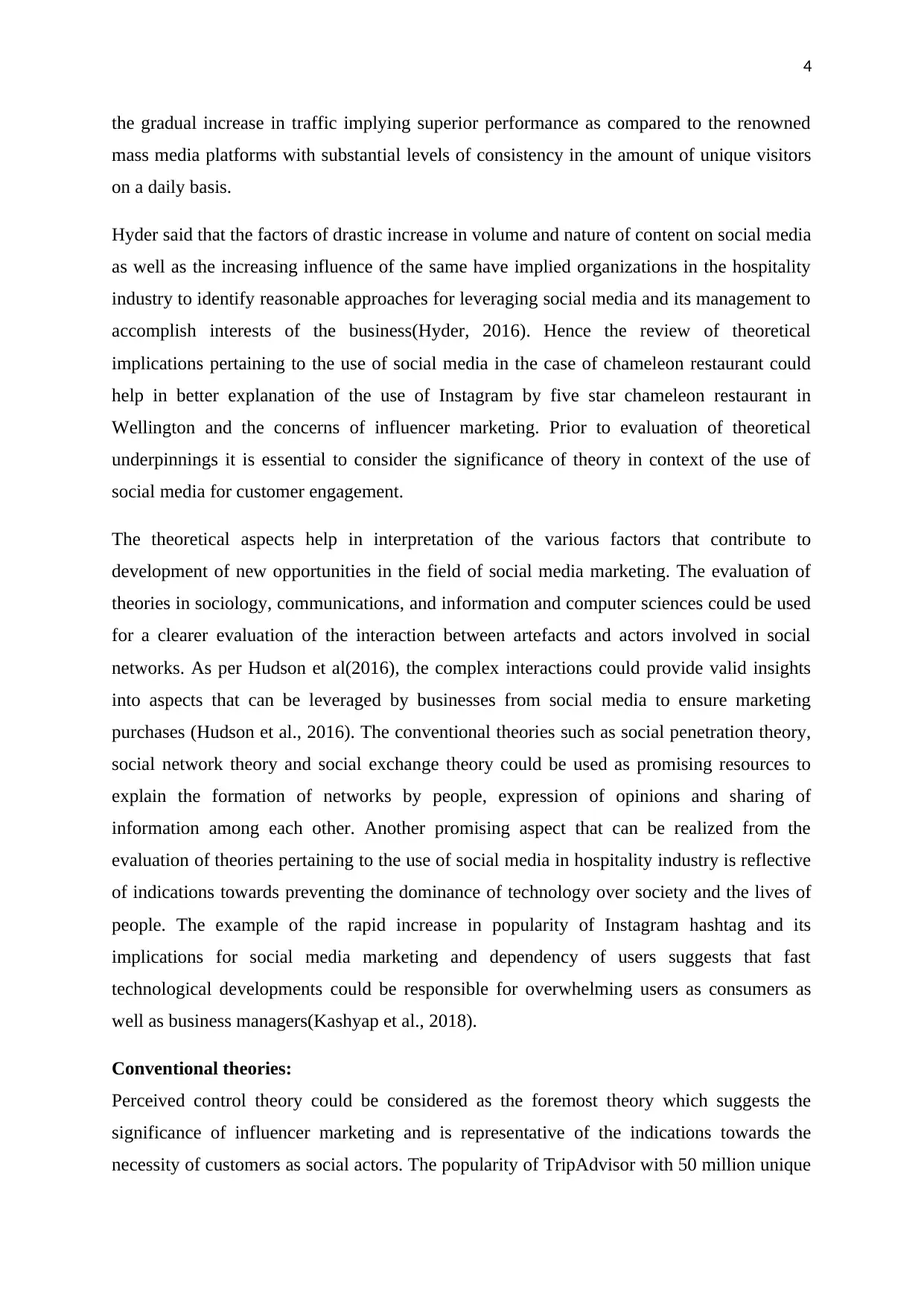
4
the gradual increase in traffic implying superior performance as compared to the renowned
mass media platforms with substantial levels of consistency in the amount of unique visitors
on a daily basis.
Hyder said that the factors of drastic increase in volume and nature of content on social media
as well as the increasing influence of the same have implied organizations in the hospitality
industry to identify reasonable approaches for leveraging social media and its management to
accomplish interests of the business(Hyder, 2016). Hence the review of theoretical
implications pertaining to the use of social media in the case of chameleon restaurant could
help in better explanation of the use of Instagram by five star chameleon restaurant in
Wellington and the concerns of influencer marketing. Prior to evaluation of theoretical
underpinnings it is essential to consider the significance of theory in context of the use of
social media for customer engagement.
The theoretical aspects help in interpretation of the various factors that contribute to
development of new opportunities in the field of social media marketing. The evaluation of
theories in sociology, communications, and information and computer sciences could be used
for a clearer evaluation of the interaction between artefacts and actors involved in social
networks. As per Hudson et al(2016), the complex interactions could provide valid insights
into aspects that can be leveraged by businesses from social media to ensure marketing
purchases (Hudson et al., 2016). The conventional theories such as social penetration theory,
social network theory and social exchange theory could be used as promising resources to
explain the formation of networks by people, expression of opinions and sharing of
information among each other. Another promising aspect that can be realized from the
evaluation of theories pertaining to the use of social media in hospitality industry is reflective
of indications towards preventing the dominance of technology over society and the lives of
people. The example of the rapid increase in popularity of Instagram hashtag and its
implications for social media marketing and dependency of users suggests that fast
technological developments could be responsible for overwhelming users as consumers as
well as business managers(Kashyap et al., 2018).
Conventional theories:
Perceived control theory could be considered as the foremost theory which suggests the
significance of influencer marketing and is representative of the indications towards the
necessity of customers as social actors. The popularity of TripAdvisor with 50 million unique
the gradual increase in traffic implying superior performance as compared to the renowned
mass media platforms with substantial levels of consistency in the amount of unique visitors
on a daily basis.
Hyder said that the factors of drastic increase in volume and nature of content on social media
as well as the increasing influence of the same have implied organizations in the hospitality
industry to identify reasonable approaches for leveraging social media and its management to
accomplish interests of the business(Hyder, 2016). Hence the review of theoretical
implications pertaining to the use of social media in the case of chameleon restaurant could
help in better explanation of the use of Instagram by five star chameleon restaurant in
Wellington and the concerns of influencer marketing. Prior to evaluation of theoretical
underpinnings it is essential to consider the significance of theory in context of the use of
social media for customer engagement.
The theoretical aspects help in interpretation of the various factors that contribute to
development of new opportunities in the field of social media marketing. The evaluation of
theories in sociology, communications, and information and computer sciences could be used
for a clearer evaluation of the interaction between artefacts and actors involved in social
networks. As per Hudson et al(2016), the complex interactions could provide valid insights
into aspects that can be leveraged by businesses from social media to ensure marketing
purchases (Hudson et al., 2016). The conventional theories such as social penetration theory,
social network theory and social exchange theory could be used as promising resources to
explain the formation of networks by people, expression of opinions and sharing of
information among each other. Another promising aspect that can be realized from the
evaluation of theories pertaining to the use of social media in hospitality industry is reflective
of indications towards preventing the dominance of technology over society and the lives of
people. The example of the rapid increase in popularity of Instagram hashtag and its
implications for social media marketing and dependency of users suggests that fast
technological developments could be responsible for overwhelming users as consumers as
well as business managers(Kashyap et al., 2018).
Conventional theories:
Perceived control theory could be considered as the foremost theory which suggests the
significance of influencer marketing and is representative of the indications towards the
necessity of customers as social actors. The popularity of TripAdvisor with 50 million unique
Secure Best Marks with AI Grader
Need help grading? Try our AI Grader for instant feedback on your assignments.
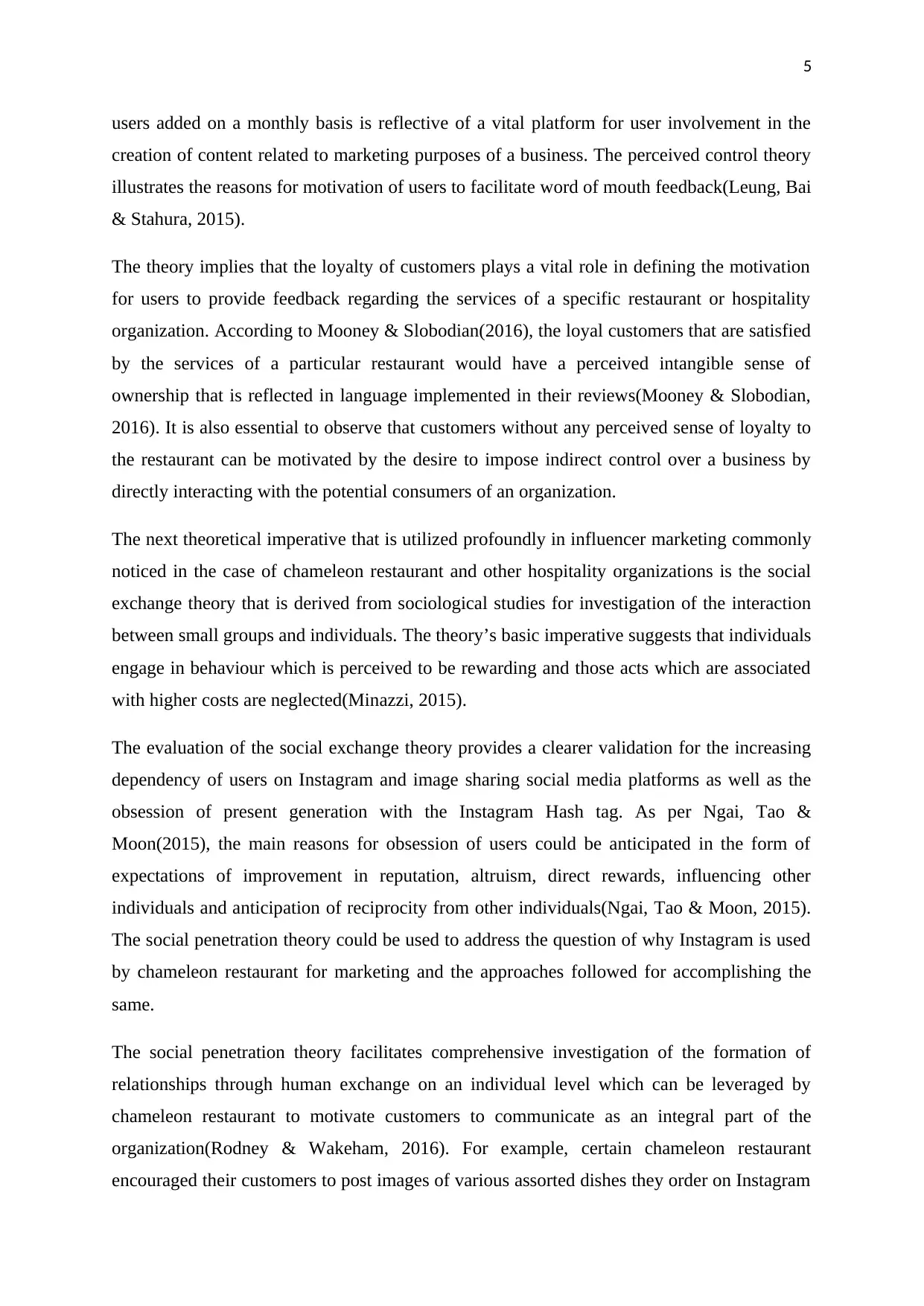
5
users added on a monthly basis is reflective of a vital platform for user involvement in the
creation of content related to marketing purposes of a business. The perceived control theory
illustrates the reasons for motivation of users to facilitate word of mouth feedback(Leung, Bai
& Stahura, 2015).
The theory implies that the loyalty of customers plays a vital role in defining the motivation
for users to provide feedback regarding the services of a specific restaurant or hospitality
organization. According to Mooney & Slobodian(2016), the loyal customers that are satisfied
by the services of a particular restaurant would have a perceived intangible sense of
ownership that is reflected in language implemented in their reviews(Mooney & Slobodian,
2016). It is also essential to observe that customers without any perceived sense of loyalty to
the restaurant can be motivated by the desire to impose indirect control over a business by
directly interacting with the potential consumers of an organization.
The next theoretical imperative that is utilized profoundly in influencer marketing commonly
noticed in the case of chameleon restaurant and other hospitality organizations is the social
exchange theory that is derived from sociological studies for investigation of the interaction
between small groups and individuals. The theory’s basic imperative suggests that individuals
engage in behaviour which is perceived to be rewarding and those acts which are associated
with higher costs are neglected(Minazzi, 2015).
The evaluation of the social exchange theory provides a clearer validation for the increasing
dependency of users on Instagram and image sharing social media platforms as well as the
obsession of present generation with the Instagram Hash tag. As per Ngai, Tao &
Moon(2015), the main reasons for obsession of users could be anticipated in the form of
expectations of improvement in reputation, altruism, direct rewards, influencing other
individuals and anticipation of reciprocity from other individuals(Ngai, Tao & Moon, 2015).
The social penetration theory could be used to address the question of why Instagram is used
by chameleon restaurant for marketing and the approaches followed for accomplishing the
same.
The social penetration theory facilitates comprehensive investigation of the formation of
relationships through human exchange on an individual level which can be leveraged by
chameleon restaurant to motivate customers to communicate as an integral part of the
organization(Rodney & Wakeham, 2016). For example, certain chameleon restaurant
encouraged their customers to post images of various assorted dishes they order on Instagram
users added on a monthly basis is reflective of a vital platform for user involvement in the
creation of content related to marketing purposes of a business. The perceived control theory
illustrates the reasons for motivation of users to facilitate word of mouth feedback(Leung, Bai
& Stahura, 2015).
The theory implies that the loyalty of customers plays a vital role in defining the motivation
for users to provide feedback regarding the services of a specific restaurant or hospitality
organization. According to Mooney & Slobodian(2016), the loyal customers that are satisfied
by the services of a particular restaurant would have a perceived intangible sense of
ownership that is reflected in language implemented in their reviews(Mooney & Slobodian,
2016). It is also essential to observe that customers without any perceived sense of loyalty to
the restaurant can be motivated by the desire to impose indirect control over a business by
directly interacting with the potential consumers of an organization.
The next theoretical imperative that is utilized profoundly in influencer marketing commonly
noticed in the case of chameleon restaurant and other hospitality organizations is the social
exchange theory that is derived from sociological studies for investigation of the interaction
between small groups and individuals. The theory’s basic imperative suggests that individuals
engage in behaviour which is perceived to be rewarding and those acts which are associated
with higher costs are neglected(Minazzi, 2015).
The evaluation of the social exchange theory provides a clearer validation for the increasing
dependency of users on Instagram and image sharing social media platforms as well as the
obsession of present generation with the Instagram Hash tag. As per Ngai, Tao &
Moon(2015), the main reasons for obsession of users could be anticipated in the form of
expectations of improvement in reputation, altruism, direct rewards, influencing other
individuals and anticipation of reciprocity from other individuals(Ngai, Tao & Moon, 2015).
The social penetration theory could be used to address the question of why Instagram is used
by chameleon restaurant for marketing and the approaches followed for accomplishing the
same.
The social penetration theory facilitates comprehensive investigation of the formation of
relationships through human exchange on an individual level which can be leveraged by
chameleon restaurant to motivate customers to communicate as an integral part of the
organization(Rodney & Wakeham, 2016). For example, certain chameleon restaurant
encouraged their customers to post images of various assorted dishes they order on Instagram
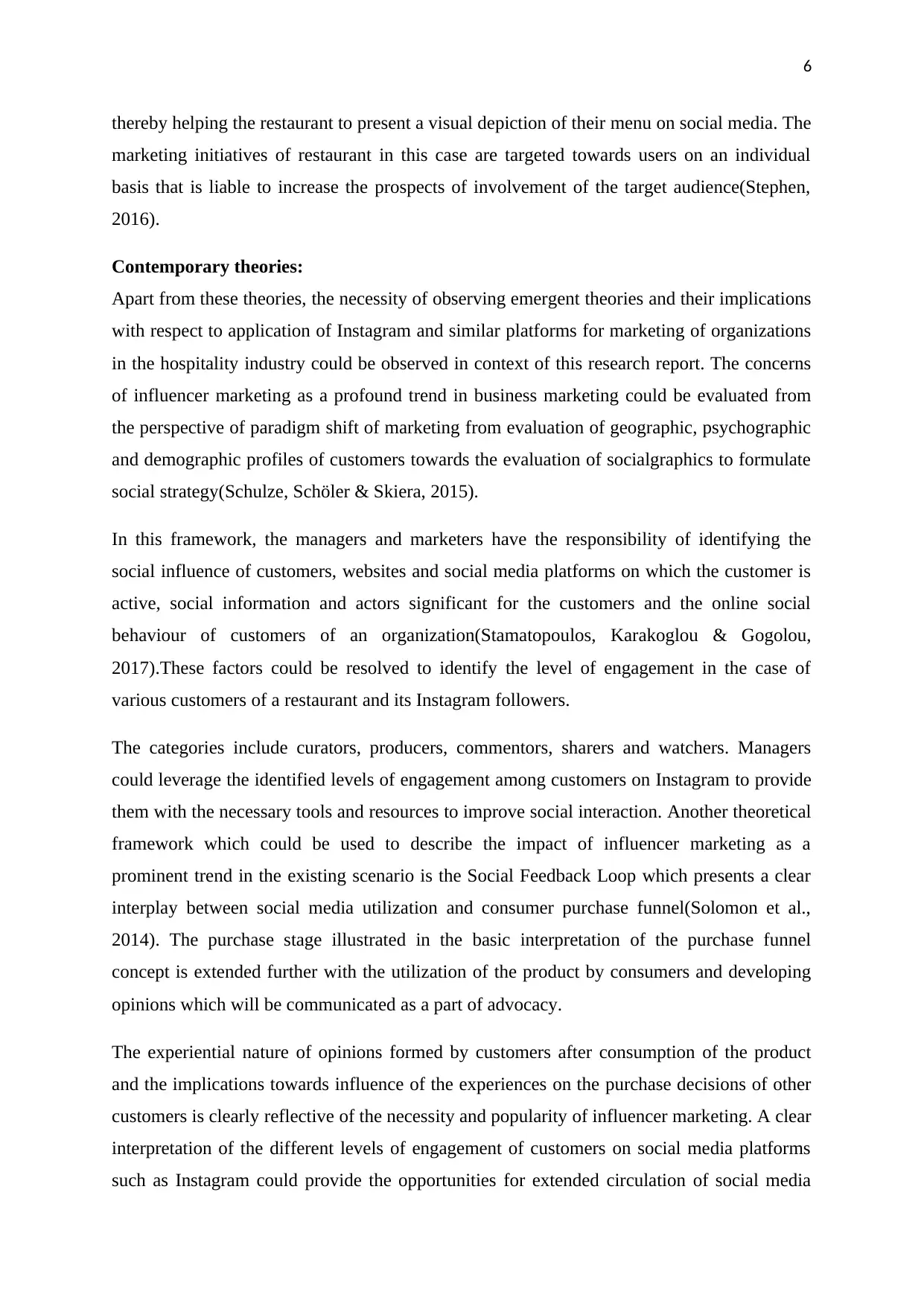
6
thereby helping the restaurant to present a visual depiction of their menu on social media. The
marketing initiatives of restaurant in this case are targeted towards users on an individual
basis that is liable to increase the prospects of involvement of the target audience(Stephen,
2016).
Contemporary theories:
Apart from these theories, the necessity of observing emergent theories and their implications
with respect to application of Instagram and similar platforms for marketing of organizations
in the hospitality industry could be observed in context of this research report. The concerns
of influencer marketing as a profound trend in business marketing could be evaluated from
the perspective of paradigm shift of marketing from evaluation of geographic, psychographic
and demographic profiles of customers towards the evaluation of socialgraphics to formulate
social strategy(Schulze, Schöler & Skiera, 2015).
In this framework, the managers and marketers have the responsibility of identifying the
social influence of customers, websites and social media platforms on which the customer is
active, social information and actors significant for the customers and the online social
behaviour of customers of an organization(Stamatopoulos, Karakoglou & Gogolou,
2017).These factors could be resolved to identify the level of engagement in the case of
various customers of a restaurant and its Instagram followers.
The categories include curators, producers, commentors, sharers and watchers. Managers
could leverage the identified levels of engagement among customers on Instagram to provide
them with the necessary tools and resources to improve social interaction. Another theoretical
framework which could be used to describe the impact of influencer marketing as a
prominent trend in the existing scenario is the Social Feedback Loop which presents a clear
interplay between social media utilization and consumer purchase funnel(Solomon et al.,
2014). The purchase stage illustrated in the basic interpretation of the purchase funnel
concept is extended further with the utilization of the product by consumers and developing
opinions which will be communicated as a part of advocacy.
The experiential nature of opinions formed by customers after consumption of the product
and the implications towards influence of the experiences on the purchase decisions of other
customers is clearly reflective of the necessity and popularity of influencer marketing. A clear
interpretation of the different levels of engagement of customers on social media platforms
such as Instagram could provide the opportunities for extended circulation of social media
thereby helping the restaurant to present a visual depiction of their menu on social media. The
marketing initiatives of restaurant in this case are targeted towards users on an individual
basis that is liable to increase the prospects of involvement of the target audience(Stephen,
2016).
Contemporary theories:
Apart from these theories, the necessity of observing emergent theories and their implications
with respect to application of Instagram and similar platforms for marketing of organizations
in the hospitality industry could be observed in context of this research report. The concerns
of influencer marketing as a profound trend in business marketing could be evaluated from
the perspective of paradigm shift of marketing from evaluation of geographic, psychographic
and demographic profiles of customers towards the evaluation of socialgraphics to formulate
social strategy(Schulze, Schöler & Skiera, 2015).
In this framework, the managers and marketers have the responsibility of identifying the
social influence of customers, websites and social media platforms on which the customer is
active, social information and actors significant for the customers and the online social
behaviour of customers of an organization(Stamatopoulos, Karakoglou & Gogolou,
2017).These factors could be resolved to identify the level of engagement in the case of
various customers of a restaurant and its Instagram followers.
The categories include curators, producers, commentors, sharers and watchers. Managers
could leverage the identified levels of engagement among customers on Instagram to provide
them with the necessary tools and resources to improve social interaction. Another theoretical
framework which could be used to describe the impact of influencer marketing as a
prominent trend in the existing scenario is the Social Feedback Loop which presents a clear
interplay between social media utilization and consumer purchase funnel(Solomon et al.,
2014). The purchase stage illustrated in the basic interpretation of the purchase funnel
concept is extended further with the utilization of the product by consumers and developing
opinions which will be communicated as a part of advocacy.
The experiential nature of opinions formed by customers after consumption of the product
and the implications towards influence of the experiences on the purchase decisions of other
customers is clearly reflective of the necessity and popularity of influencer marketing. A clear
interpretation of the different levels of engagement of customers on social media platforms
such as Instagram could provide the opportunities for extended circulation of social media
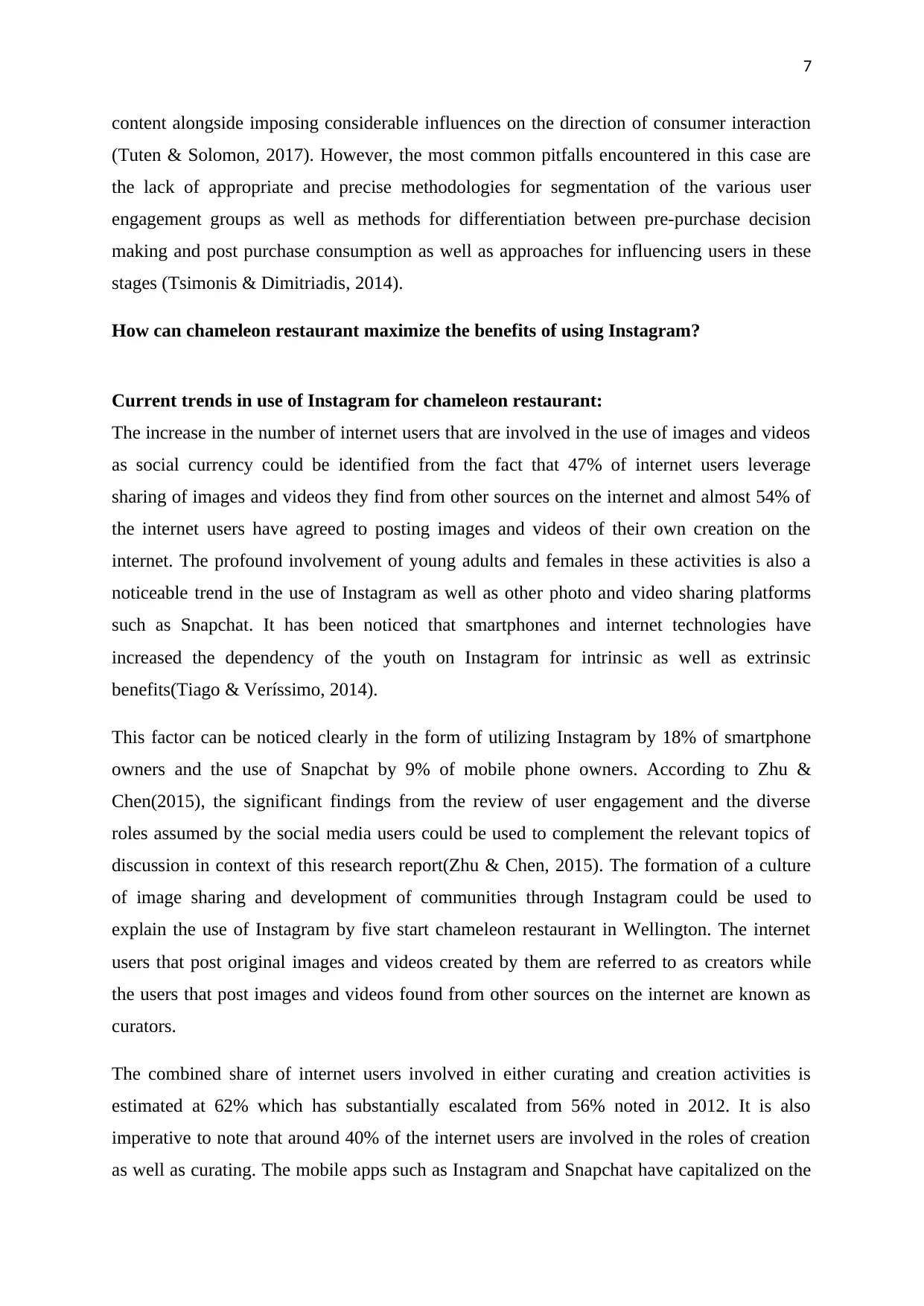
7
content alongside imposing considerable influences on the direction of consumer interaction
(Tuten & Solomon, 2017). However, the most common pitfalls encountered in this case are
the lack of appropriate and precise methodologies for segmentation of the various user
engagement groups as well as methods for differentiation between pre-purchase decision
making and post purchase consumption as well as approaches for influencing users in these
stages (Tsimonis & Dimitriadis, 2014).
How can chameleon restaurant maximize the benefits of using Instagram?
Current trends in use of Instagram for chameleon restaurant:
The increase in the number of internet users that are involved in the use of images and videos
as social currency could be identified from the fact that 47% of internet users leverage
sharing of images and videos they find from other sources on the internet and almost 54% of
the internet users have agreed to posting images and videos of their own creation on the
internet. The profound involvement of young adults and females in these activities is also a
noticeable trend in the use of Instagram as well as other photo and video sharing platforms
such as Snapchat. It has been noticed that smartphones and internet technologies have
increased the dependency of the youth on Instagram for intrinsic as well as extrinsic
benefits(Tiago & Veríssimo, 2014).
This factor can be noticed clearly in the form of utilizing Instagram by 18% of smartphone
owners and the use of Snapchat by 9% of mobile phone owners. According to Zhu &
Chen(2015), the significant findings from the review of user engagement and the diverse
roles assumed by the social media users could be used to complement the relevant topics of
discussion in context of this research report(Zhu & Chen, 2015). The formation of a culture
of image sharing and development of communities through Instagram could be used to
explain the use of Instagram by five start chameleon restaurant in Wellington. The internet
users that post original images and videos created by them are referred to as creators while
the users that post images and videos found from other sources on the internet are known as
curators.
The combined share of internet users involved in either curating and creation activities is
estimated at 62% which has substantially escalated from 56% noted in 2012. It is also
imperative to note that around 40% of the internet users are involved in the roles of creation
as well as curating. The mobile apps such as Instagram and Snapchat have capitalized on the
content alongside imposing considerable influences on the direction of consumer interaction
(Tuten & Solomon, 2017). However, the most common pitfalls encountered in this case are
the lack of appropriate and precise methodologies for segmentation of the various user
engagement groups as well as methods for differentiation between pre-purchase decision
making and post purchase consumption as well as approaches for influencing users in these
stages (Tsimonis & Dimitriadis, 2014).
How can chameleon restaurant maximize the benefits of using Instagram?
Current trends in use of Instagram for chameleon restaurant:
The increase in the number of internet users that are involved in the use of images and videos
as social currency could be identified from the fact that 47% of internet users leverage
sharing of images and videos they find from other sources on the internet and almost 54% of
the internet users have agreed to posting images and videos of their own creation on the
internet. The profound involvement of young adults and females in these activities is also a
noticeable trend in the use of Instagram as well as other photo and video sharing platforms
such as Snapchat. It has been noticed that smartphones and internet technologies have
increased the dependency of the youth on Instagram for intrinsic as well as extrinsic
benefits(Tiago & Veríssimo, 2014).
This factor can be noticed clearly in the form of utilizing Instagram by 18% of smartphone
owners and the use of Snapchat by 9% of mobile phone owners. According to Zhu &
Chen(2015), the significant findings from the review of user engagement and the diverse
roles assumed by the social media users could be used to complement the relevant topics of
discussion in context of this research report(Zhu & Chen, 2015). The formation of a culture
of image sharing and development of communities through Instagram could be used to
explain the use of Instagram by five start chameleon restaurant in Wellington. The internet
users that post original images and videos created by them are referred to as creators while
the users that post images and videos found from other sources on the internet are known as
curators.
The combined share of internet users involved in either curating and creation activities is
estimated at 62% which has substantially escalated from 56% noted in 2012. It is also
imperative to note that around 40% of the internet users are involved in the roles of creation
as well as curating. The mobile apps such as Instagram and Snapchat have capitalized on the
Paraphrase This Document
Need a fresh take? Get an instant paraphrase of this document with our AI Paraphraser
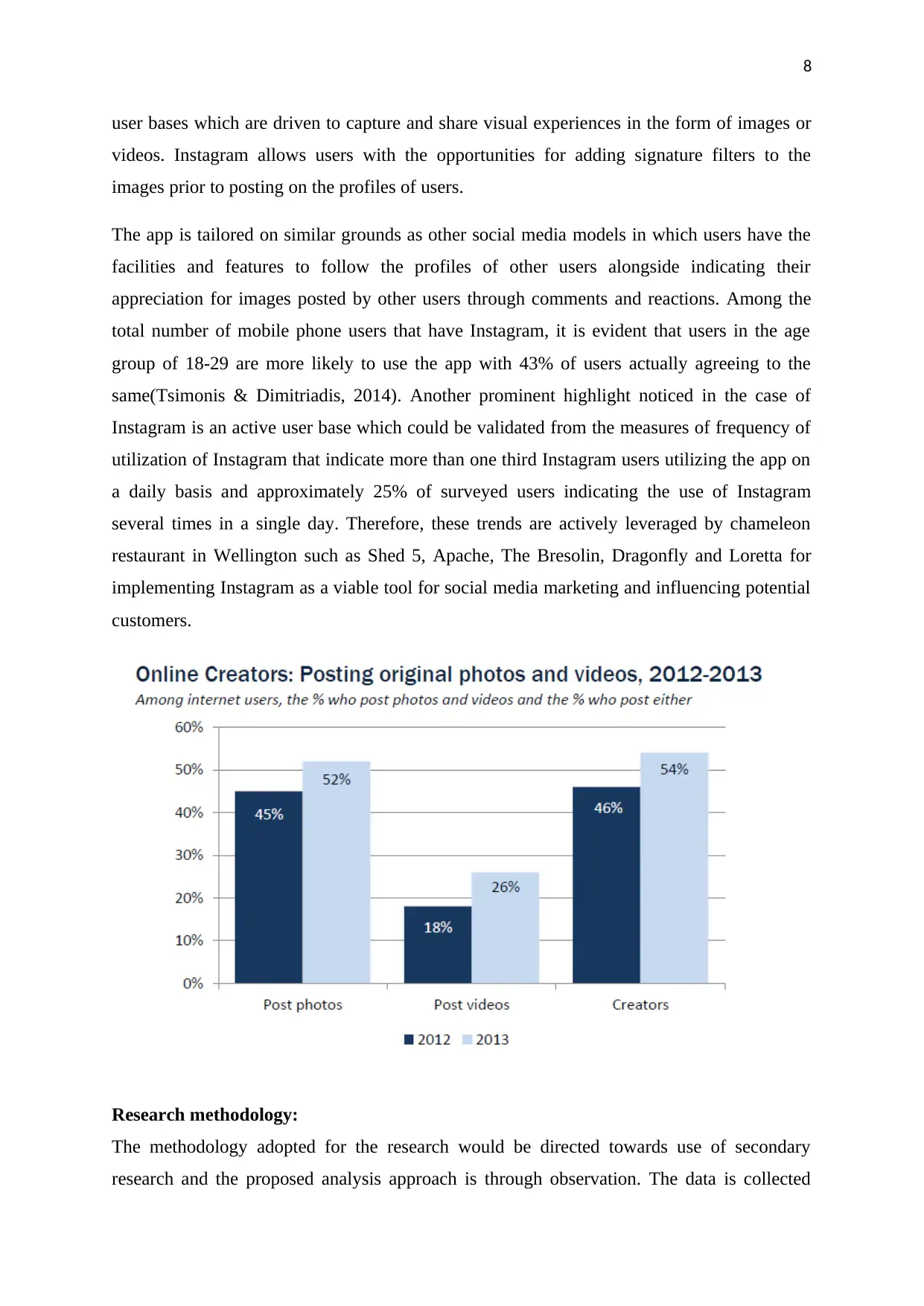
8
user bases which are driven to capture and share visual experiences in the form of images or
videos. Instagram allows users with the opportunities for adding signature filters to the
images prior to posting on the profiles of users.
The app is tailored on similar grounds as other social media models in which users have the
facilities and features to follow the profiles of other users alongside indicating their
appreciation for images posted by other users through comments and reactions. Among the
total number of mobile phone users that have Instagram, it is evident that users in the age
group of 18-29 are more likely to use the app with 43% of users actually agreeing to the
same(Tsimonis & Dimitriadis, 2014). Another prominent highlight noticed in the case of
Instagram is an active user base which could be validated from the measures of frequency of
utilization of Instagram that indicate more than one third Instagram users utilizing the app on
a daily basis and approximately 25% of surveyed users indicating the use of Instagram
several times in a single day. Therefore, these trends are actively leveraged by chameleon
restaurant in Wellington such as Shed 5, Apache, The Bresolin, Dragonfly and Loretta for
implementing Instagram as a viable tool for social media marketing and influencing potential
customers.
Research methodology:
The methodology adopted for the research would be directed towards use of secondary
research and the proposed analysis approach is through observation. The data is collected
user bases which are driven to capture and share visual experiences in the form of images or
videos. Instagram allows users with the opportunities for adding signature filters to the
images prior to posting on the profiles of users.
The app is tailored on similar grounds as other social media models in which users have the
facilities and features to follow the profiles of other users alongside indicating their
appreciation for images posted by other users through comments and reactions. Among the
total number of mobile phone users that have Instagram, it is evident that users in the age
group of 18-29 are more likely to use the app with 43% of users actually agreeing to the
same(Tsimonis & Dimitriadis, 2014). Another prominent highlight noticed in the case of
Instagram is an active user base which could be validated from the measures of frequency of
utilization of Instagram that indicate more than one third Instagram users utilizing the app on
a daily basis and approximately 25% of surveyed users indicating the use of Instagram
several times in a single day. Therefore, these trends are actively leveraged by chameleon
restaurant in Wellington such as Shed 5, Apache, The Bresolin, Dragonfly and Loretta for
implementing Instagram as a viable tool for social media marketing and influencing potential
customers.
Research methodology:
The methodology adopted for the research would be directed towards use of secondary
research and the proposed analysis approach is through observation. The data is collected
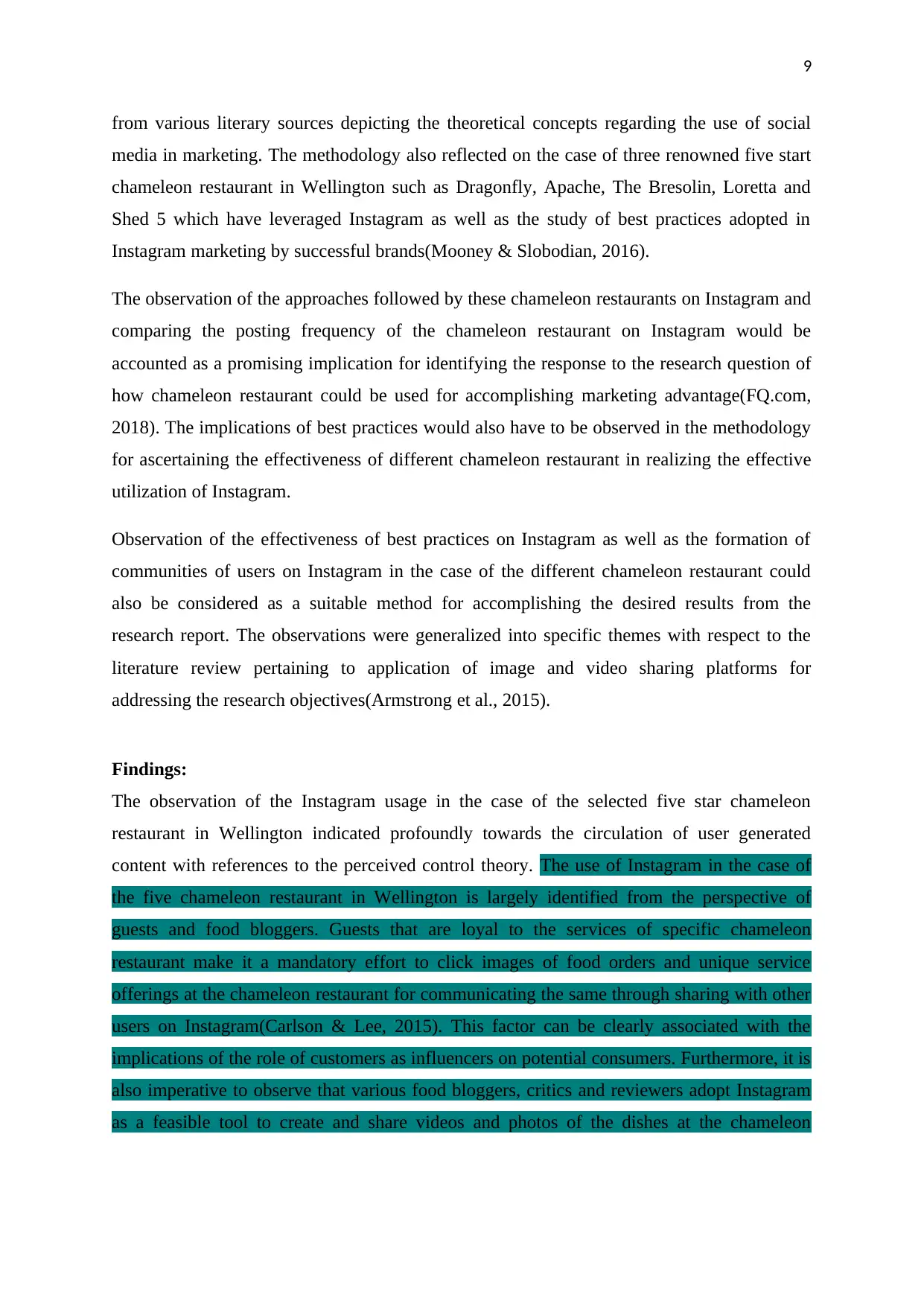
9
from various literary sources depicting the theoretical concepts regarding the use of social
media in marketing. The methodology also reflected on the case of three renowned five start
chameleon restaurant in Wellington such as Dragonfly, Apache, The Bresolin, Loretta and
Shed 5 which have leveraged Instagram as well as the study of best practices adopted in
Instagram marketing by successful brands(Mooney & Slobodian, 2016).
The observation of the approaches followed by these chameleon restaurants on Instagram and
comparing the posting frequency of the chameleon restaurant on Instagram would be
accounted as a promising implication for identifying the response to the research question of
how chameleon restaurant could be used for accomplishing marketing advantage(FQ.com,
2018). The implications of best practices would also have to be observed in the methodology
for ascertaining the effectiveness of different chameleon restaurant in realizing the effective
utilization of Instagram.
Observation of the effectiveness of best practices on Instagram as well as the formation of
communities of users on Instagram in the case of the different chameleon restaurant could
also be considered as a suitable method for accomplishing the desired results from the
research report. The observations were generalized into specific themes with respect to the
literature review pertaining to application of image and video sharing platforms for
addressing the research objectives(Armstrong et al., 2015).
Findings:
The observation of the Instagram usage in the case of the selected five star chameleon
restaurant in Wellington indicated profoundly towards the circulation of user generated
content with references to the perceived control theory. The use of Instagram in the case of
the five chameleon restaurant in Wellington is largely identified from the perspective of
guests and food bloggers. Guests that are loyal to the services of specific chameleon
restaurant make it a mandatory effort to click images of food orders and unique service
offerings at the chameleon restaurant for communicating the same through sharing with other
users on Instagram(Carlson & Lee, 2015). This factor can be clearly associated with the
implications of the role of customers as influencers on potential consumers. Furthermore, it is
also imperative to observe that various food bloggers, critics and reviewers adopt Instagram
as a feasible tool to create and share videos and photos of the dishes at the chameleon
from various literary sources depicting the theoretical concepts regarding the use of social
media in marketing. The methodology also reflected on the case of three renowned five start
chameleon restaurant in Wellington such as Dragonfly, Apache, The Bresolin, Loretta and
Shed 5 which have leveraged Instagram as well as the study of best practices adopted in
Instagram marketing by successful brands(Mooney & Slobodian, 2016).
The observation of the approaches followed by these chameleon restaurants on Instagram and
comparing the posting frequency of the chameleon restaurant on Instagram would be
accounted as a promising implication for identifying the response to the research question of
how chameleon restaurant could be used for accomplishing marketing advantage(FQ.com,
2018). The implications of best practices would also have to be observed in the methodology
for ascertaining the effectiveness of different chameleon restaurant in realizing the effective
utilization of Instagram.
Observation of the effectiveness of best practices on Instagram as well as the formation of
communities of users on Instagram in the case of the different chameleon restaurant could
also be considered as a suitable method for accomplishing the desired results from the
research report. The observations were generalized into specific themes with respect to the
literature review pertaining to application of image and video sharing platforms for
addressing the research objectives(Armstrong et al., 2015).
Findings:
The observation of the Instagram usage in the case of the selected five star chameleon
restaurant in Wellington indicated profoundly towards the circulation of user generated
content with references to the perceived control theory. The use of Instagram in the case of
the five chameleon restaurant in Wellington is largely identified from the perspective of
guests and food bloggers. Guests that are loyal to the services of specific chameleon
restaurant make it a mandatory effort to click images of food orders and unique service
offerings at the chameleon restaurant for communicating the same through sharing with other
users on Instagram(Carlson & Lee, 2015). This factor can be clearly associated with the
implications of the role of customers as influencers on potential consumers. Furthermore, it is
also imperative to observe that various food bloggers, critics and reviewers adopt Instagram
as a feasible tool to create and share videos and photos of the dishes at the chameleon
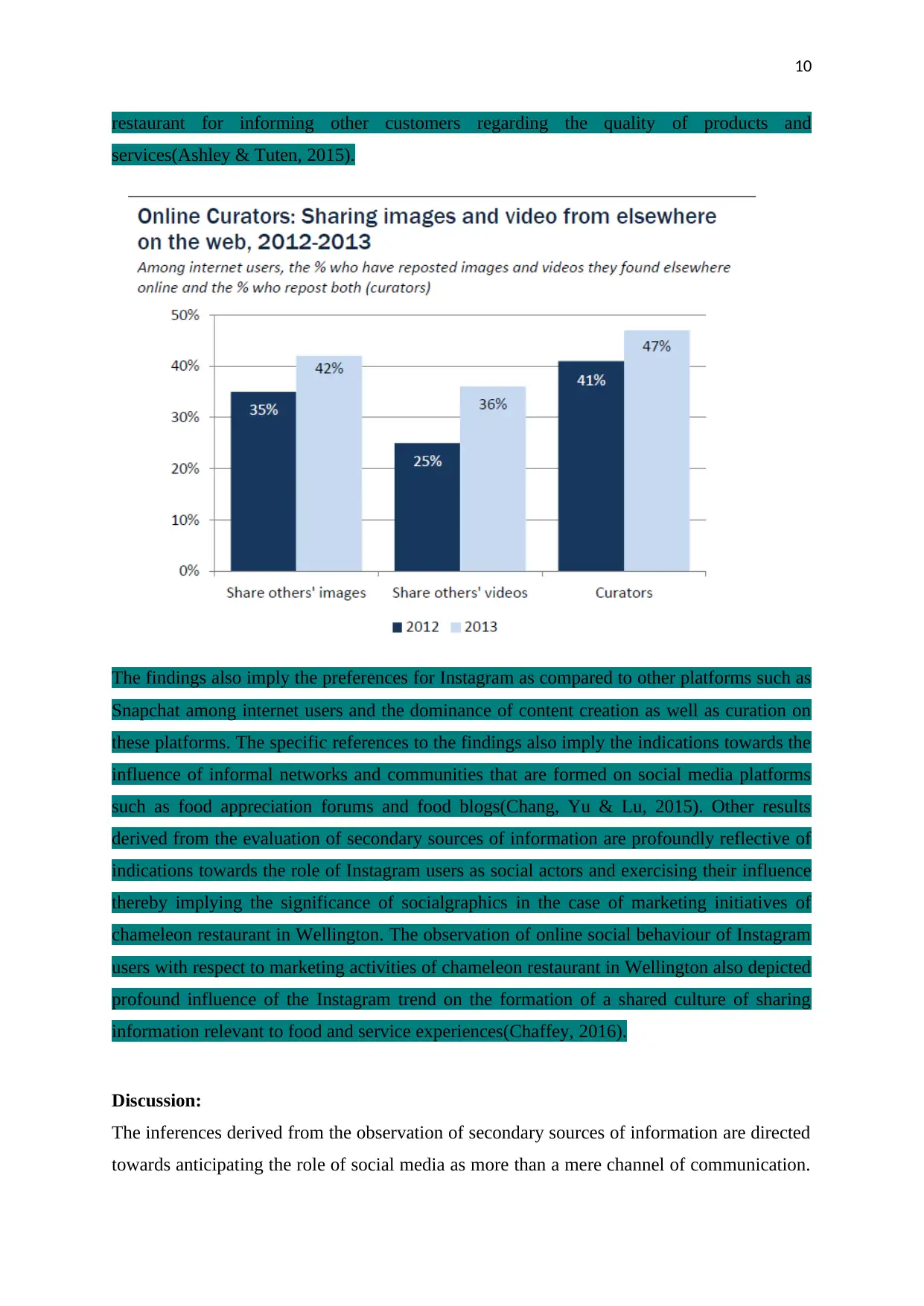
10
restaurant for informing other customers regarding the quality of products and
services(Ashley & Tuten, 2015).
The findings also imply the preferences for Instagram as compared to other platforms such as
Snapchat among internet users and the dominance of content creation as well as curation on
these platforms. The specific references to the findings also imply the indications towards the
influence of informal networks and communities that are formed on social media platforms
such as food appreciation forums and food blogs(Chang, Yu & Lu, 2015). Other results
derived from the evaluation of secondary sources of information are profoundly reflective of
indications towards the role of Instagram users as social actors and exercising their influence
thereby implying the significance of socialgraphics in the case of marketing initiatives of
chameleon restaurant in Wellington. The observation of online social behaviour of Instagram
users with respect to marketing activities of chameleon restaurant in Wellington also depicted
profound influence of the Instagram trend on the formation of a shared culture of sharing
information relevant to food and service experiences(Chaffey, 2016).
Discussion:
The inferences derived from the observation of secondary sources of information are directed
towards anticipating the role of social media as more than a mere channel of communication.
restaurant for informing other customers regarding the quality of products and
services(Ashley & Tuten, 2015).
The findings also imply the preferences for Instagram as compared to other platforms such as
Snapchat among internet users and the dominance of content creation as well as curation on
these platforms. The specific references to the findings also imply the indications towards the
influence of informal networks and communities that are formed on social media platforms
such as food appreciation forums and food blogs(Chang, Yu & Lu, 2015). Other results
derived from the evaluation of secondary sources of information are profoundly reflective of
indications towards the role of Instagram users as social actors and exercising their influence
thereby implying the significance of socialgraphics in the case of marketing initiatives of
chameleon restaurant in Wellington. The observation of online social behaviour of Instagram
users with respect to marketing activities of chameleon restaurant in Wellington also depicted
profound influence of the Instagram trend on the formation of a shared culture of sharing
information relevant to food and service experiences(Chaffey, 2016).
Discussion:
The inferences derived from the observation of secondary sources of information are directed
towards anticipating the role of social media as more than a mere channel of communication.
Secure Best Marks with AI Grader
Need help grading? Try our AI Grader for instant feedback on your assignments.
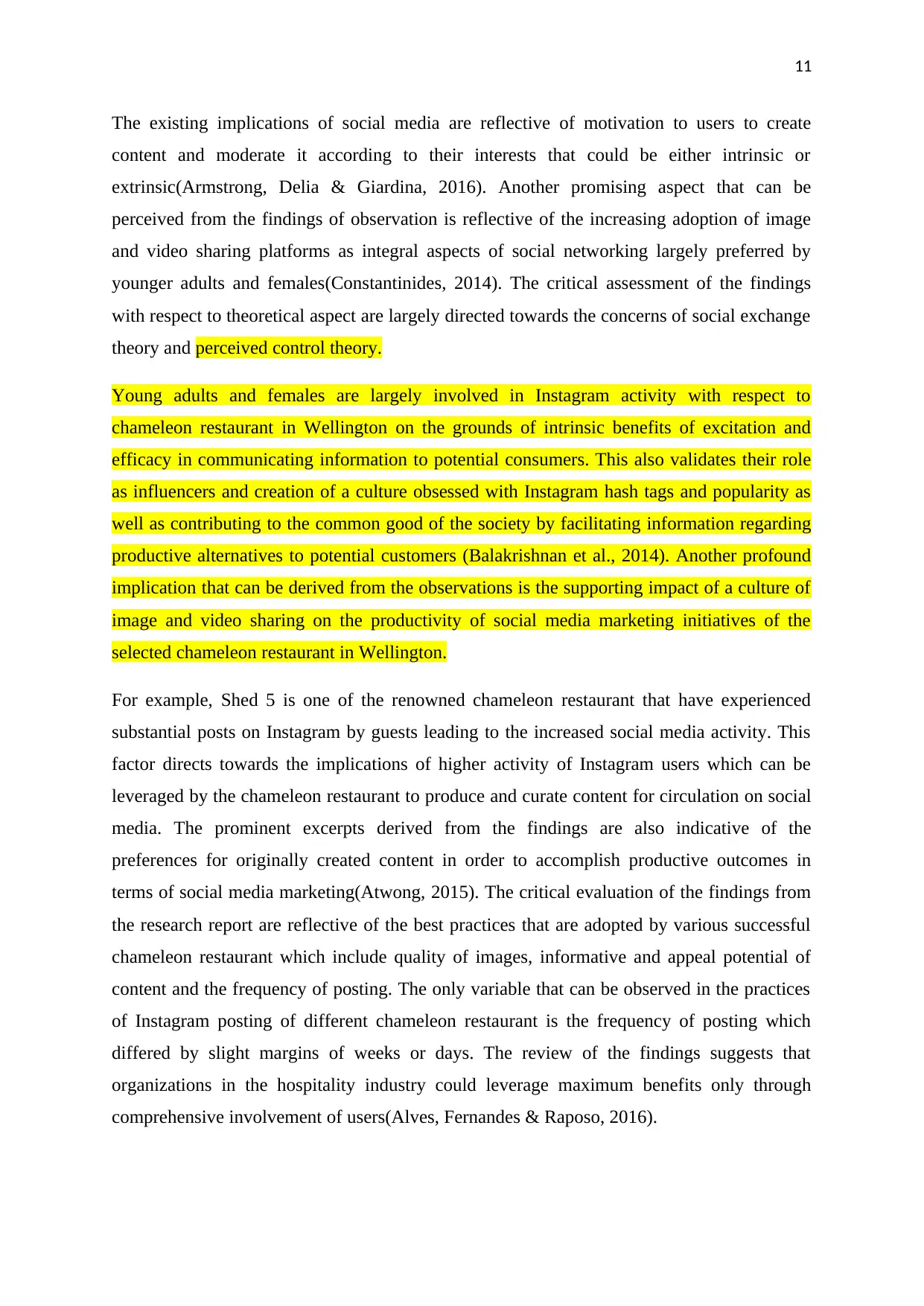
11
The existing implications of social media are reflective of motivation to users to create
content and moderate it according to their interests that could be either intrinsic or
extrinsic(Armstrong, Delia & Giardina, 2016). Another promising aspect that can be
perceived from the findings of observation is reflective of the increasing adoption of image
and video sharing platforms as integral aspects of social networking largely preferred by
younger adults and females(Constantinides, 2014). The critical assessment of the findings
with respect to theoretical aspect are largely directed towards the concerns of social exchange
theory and perceived control theory.
Young adults and females are largely involved in Instagram activity with respect to
chameleon restaurant in Wellington on the grounds of intrinsic benefits of excitation and
efficacy in communicating information to potential consumers. This also validates their role
as influencers and creation of a culture obsessed with Instagram hash tags and popularity as
well as contributing to the common good of the society by facilitating information regarding
productive alternatives to potential customers (Balakrishnan et al., 2014). Another profound
implication that can be derived from the observations is the supporting impact of a culture of
image and video sharing on the productivity of social media marketing initiatives of the
selected chameleon restaurant in Wellington.
For example, Shed 5 is one of the renowned chameleon restaurant that have experienced
substantial posts on Instagram by guests leading to the increased social media activity. This
factor directs towards the implications of higher activity of Instagram users which can be
leveraged by the chameleon restaurant to produce and curate content for circulation on social
media. The prominent excerpts derived from the findings are also indicative of the
preferences for originally created content in order to accomplish productive outcomes in
terms of social media marketing(Atwong, 2015). The critical evaluation of the findings from
the research report are reflective of the best practices that are adopted by various successful
chameleon restaurant which include quality of images, informative and appeal potential of
content and the frequency of posting. The only variable that can be observed in the practices
of Instagram posting of different chameleon restaurant is the frequency of posting which
differed by slight margins of weeks or days. The review of the findings suggests that
organizations in the hospitality industry could leverage maximum benefits only through
comprehensive involvement of users(Alves, Fernandes & Raposo, 2016).
The existing implications of social media are reflective of motivation to users to create
content and moderate it according to their interests that could be either intrinsic or
extrinsic(Armstrong, Delia & Giardina, 2016). Another promising aspect that can be
perceived from the findings of observation is reflective of the increasing adoption of image
and video sharing platforms as integral aspects of social networking largely preferred by
younger adults and females(Constantinides, 2014). The critical assessment of the findings
with respect to theoretical aspect are largely directed towards the concerns of social exchange
theory and perceived control theory.
Young adults and females are largely involved in Instagram activity with respect to
chameleon restaurant in Wellington on the grounds of intrinsic benefits of excitation and
efficacy in communicating information to potential consumers. This also validates their role
as influencers and creation of a culture obsessed with Instagram hash tags and popularity as
well as contributing to the common good of the society by facilitating information regarding
productive alternatives to potential customers (Balakrishnan et al., 2014). Another profound
implication that can be derived from the observations is the supporting impact of a culture of
image and video sharing on the productivity of social media marketing initiatives of the
selected chameleon restaurant in Wellington.
For example, Shed 5 is one of the renowned chameleon restaurant that have experienced
substantial posts on Instagram by guests leading to the increased social media activity. This
factor directs towards the implications of higher activity of Instagram users which can be
leveraged by the chameleon restaurant to produce and curate content for circulation on social
media. The prominent excerpts derived from the findings are also indicative of the
preferences for originally created content in order to accomplish productive outcomes in
terms of social media marketing(Atwong, 2015). The critical evaluation of the findings from
the research report are reflective of the best practices that are adopted by various successful
chameleon restaurant which include quality of images, informative and appeal potential of
content and the frequency of posting. The only variable that can be observed in the practices
of Instagram posting of different chameleon restaurant is the frequency of posting which
differed by slight margins of weeks or days. The review of the findings suggests that
organizations in the hospitality industry could leverage maximum benefits only through
comprehensive involvement of users(Alves, Fernandes & Raposo, 2016).
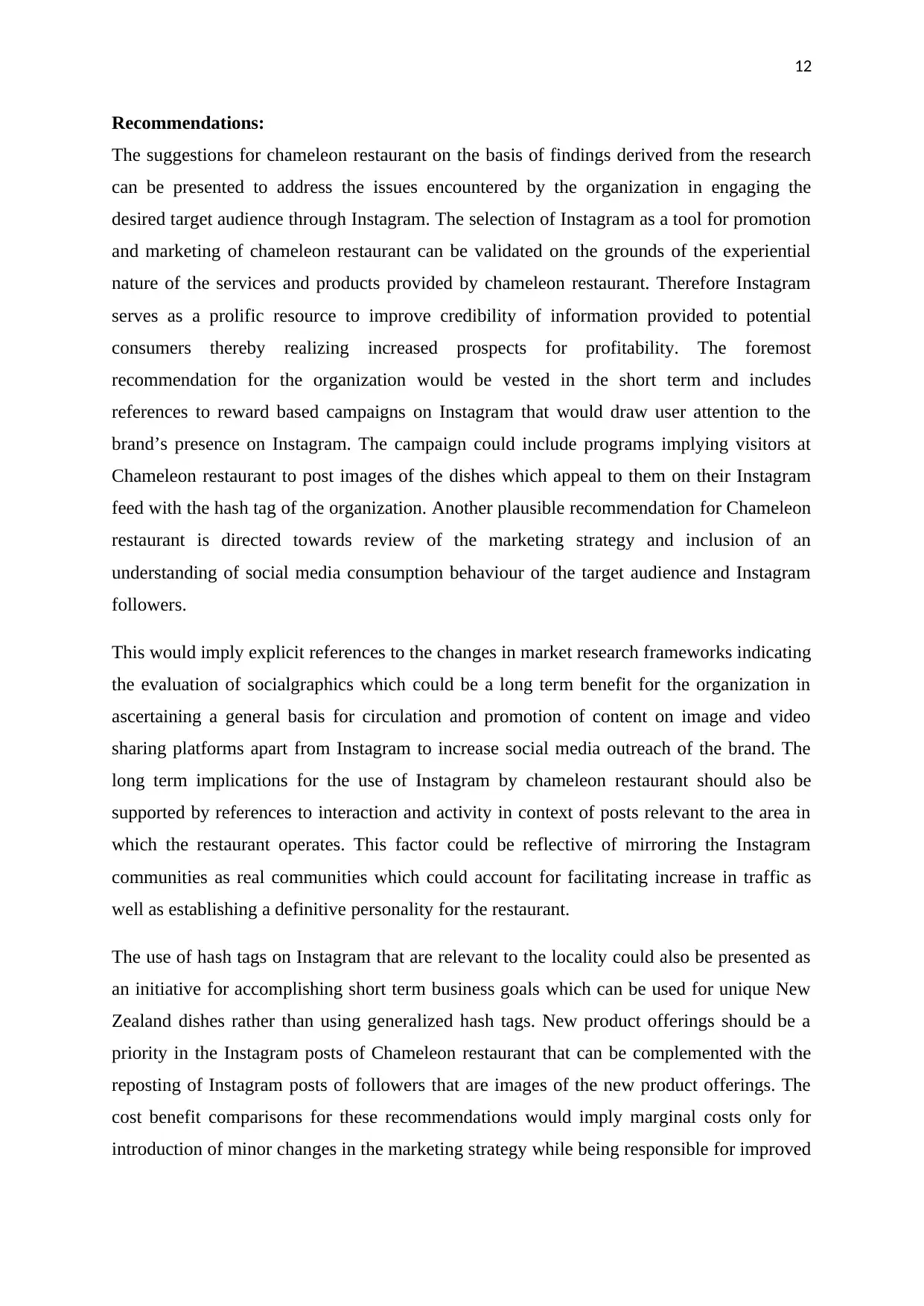
12
Recommendations:
The suggestions for chameleon restaurant on the basis of findings derived from the research
can be presented to address the issues encountered by the organization in engaging the
desired target audience through Instagram. The selection of Instagram as a tool for promotion
and marketing of chameleon restaurant can be validated on the grounds of the experiential
nature of the services and products provided by chameleon restaurant. Therefore Instagram
serves as a prolific resource to improve credibility of information provided to potential
consumers thereby realizing increased prospects for profitability. The foremost
recommendation for the organization would be vested in the short term and includes
references to reward based campaigns on Instagram that would draw user attention to the
brand’s presence on Instagram. The campaign could include programs implying visitors at
Chameleon restaurant to post images of the dishes which appeal to them on their Instagram
feed with the hash tag of the organization. Another plausible recommendation for Chameleon
restaurant is directed towards review of the marketing strategy and inclusion of an
understanding of social media consumption behaviour of the target audience and Instagram
followers.
This would imply explicit references to the changes in market research frameworks indicating
the evaluation of socialgraphics which could be a long term benefit for the organization in
ascertaining a general basis for circulation and promotion of content on image and video
sharing platforms apart from Instagram to increase social media outreach of the brand. The
long term implications for the use of Instagram by chameleon restaurant should also be
supported by references to interaction and activity in context of posts relevant to the area in
which the restaurant operates. This factor could be reflective of mirroring the Instagram
communities as real communities which could account for facilitating increase in traffic as
well as establishing a definitive personality for the restaurant.
The use of hash tags on Instagram that are relevant to the locality could also be presented as
an initiative for accomplishing short term business goals which can be used for unique New
Zealand dishes rather than using generalized hash tags. New product offerings should be a
priority in the Instagram posts of Chameleon restaurant that can be complemented with the
reposting of Instagram posts of followers that are images of the new product offerings. The
cost benefit comparisons for these recommendations would imply marginal costs only for
introduction of minor changes in the marketing strategy while being responsible for improved
Recommendations:
The suggestions for chameleon restaurant on the basis of findings derived from the research
can be presented to address the issues encountered by the organization in engaging the
desired target audience through Instagram. The selection of Instagram as a tool for promotion
and marketing of chameleon restaurant can be validated on the grounds of the experiential
nature of the services and products provided by chameleon restaurant. Therefore Instagram
serves as a prolific resource to improve credibility of information provided to potential
consumers thereby realizing increased prospects for profitability. The foremost
recommendation for the organization would be vested in the short term and includes
references to reward based campaigns on Instagram that would draw user attention to the
brand’s presence on Instagram. The campaign could include programs implying visitors at
Chameleon restaurant to post images of the dishes which appeal to them on their Instagram
feed with the hash tag of the organization. Another plausible recommendation for Chameleon
restaurant is directed towards review of the marketing strategy and inclusion of an
understanding of social media consumption behaviour of the target audience and Instagram
followers.
This would imply explicit references to the changes in market research frameworks indicating
the evaluation of socialgraphics which could be a long term benefit for the organization in
ascertaining a general basis for circulation and promotion of content on image and video
sharing platforms apart from Instagram to increase social media outreach of the brand. The
long term implications for the use of Instagram by chameleon restaurant should also be
supported by references to interaction and activity in context of posts relevant to the area in
which the restaurant operates. This factor could be reflective of mirroring the Instagram
communities as real communities which could account for facilitating increase in traffic as
well as establishing a definitive personality for the restaurant.
The use of hash tags on Instagram that are relevant to the locality could also be presented as
an initiative for accomplishing short term business goals which can be used for unique New
Zealand dishes rather than using generalized hash tags. New product offerings should be a
priority in the Instagram posts of Chameleon restaurant that can be complemented with the
reposting of Instagram posts of followers that are images of the new product offerings. The
cost benefit comparisons for these recommendations would imply marginal costs only for
introduction of minor changes in the marketing strategy while being responsible for improved
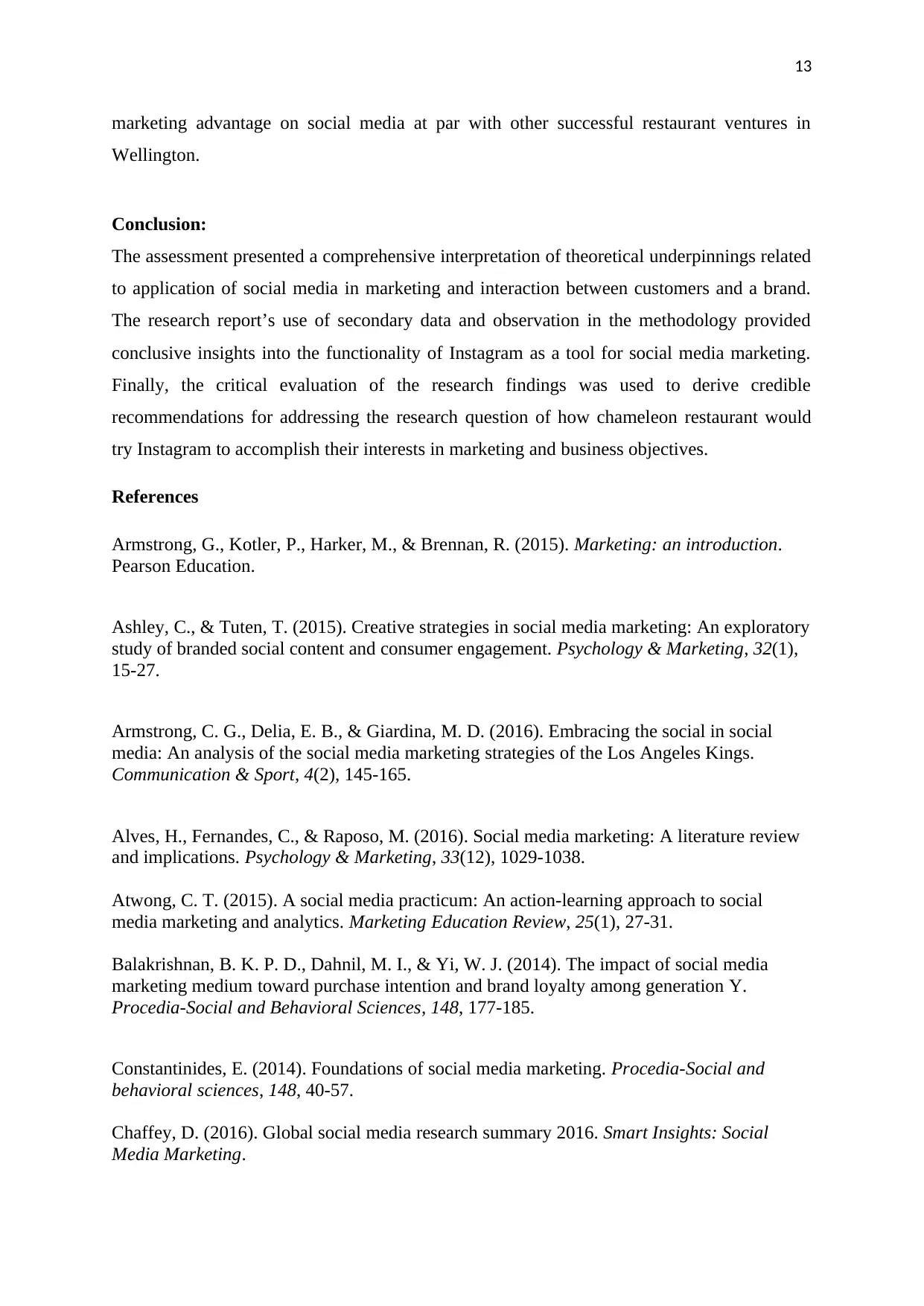
13
marketing advantage on social media at par with other successful restaurant ventures in
Wellington.
Conclusion:
The assessment presented a comprehensive interpretation of theoretical underpinnings related
to application of social media in marketing and interaction between customers and a brand.
The research report’s use of secondary data and observation in the methodology provided
conclusive insights into the functionality of Instagram as a tool for social media marketing.
Finally, the critical evaluation of the research findings was used to derive credible
recommendations for addressing the research question of how chameleon restaurant would
try Instagram to accomplish their interests in marketing and business objectives.
References
Armstrong, G., Kotler, P., Harker, M., & Brennan, R. (2015). Marketing: an introduction.
Pearson Education.
Ashley, C., & Tuten, T. (2015). Creative strategies in social media marketing: An exploratory
study of branded social content and consumer engagement. Psychology & Marketing, 32(1),
15-27.
Armstrong, C. G., Delia, E. B., & Giardina, M. D. (2016). Embracing the social in social
media: An analysis of the social media marketing strategies of the Los Angeles Kings.
Communication & Sport, 4(2), 145-165.
Alves, H., Fernandes, C., & Raposo, M. (2016). Social media marketing: A literature review
and implications. Psychology & Marketing, 33(12), 1029-1038.
Atwong, C. T. (2015). A social media practicum: An action-learning approach to social
media marketing and analytics. Marketing Education Review, 25(1), 27-31.
Balakrishnan, B. K. P. D., Dahnil, M. I., & Yi, W. J. (2014). The impact of social media
marketing medium toward purchase intention and brand loyalty among generation Y.
Procedia-Social and Behavioral Sciences, 148, 177-185.
Constantinides, E. (2014). Foundations of social media marketing. Procedia-Social and
behavioral sciences, 148, 40-57.
Chaffey, D. (2016). Global social media research summary 2016. Smart Insights: Social
Media Marketing.
marketing advantage on social media at par with other successful restaurant ventures in
Wellington.
Conclusion:
The assessment presented a comprehensive interpretation of theoretical underpinnings related
to application of social media in marketing and interaction between customers and a brand.
The research report’s use of secondary data and observation in the methodology provided
conclusive insights into the functionality of Instagram as a tool for social media marketing.
Finally, the critical evaluation of the research findings was used to derive credible
recommendations for addressing the research question of how chameleon restaurant would
try Instagram to accomplish their interests in marketing and business objectives.
References
Armstrong, G., Kotler, P., Harker, M., & Brennan, R. (2015). Marketing: an introduction.
Pearson Education.
Ashley, C., & Tuten, T. (2015). Creative strategies in social media marketing: An exploratory
study of branded social content and consumer engagement. Psychology & Marketing, 32(1),
15-27.
Armstrong, C. G., Delia, E. B., & Giardina, M. D. (2016). Embracing the social in social
media: An analysis of the social media marketing strategies of the Los Angeles Kings.
Communication & Sport, 4(2), 145-165.
Alves, H., Fernandes, C., & Raposo, M. (2016). Social media marketing: A literature review
and implications. Psychology & Marketing, 33(12), 1029-1038.
Atwong, C. T. (2015). A social media practicum: An action-learning approach to social
media marketing and analytics. Marketing Education Review, 25(1), 27-31.
Balakrishnan, B. K. P. D., Dahnil, M. I., & Yi, W. J. (2014). The impact of social media
marketing medium toward purchase intention and brand loyalty among generation Y.
Procedia-Social and Behavioral Sciences, 148, 177-185.
Constantinides, E. (2014). Foundations of social media marketing. Procedia-Social and
behavioral sciences, 148, 40-57.
Chaffey, D. (2016). Global social media research summary 2016. Smart Insights: Social
Media Marketing.
Paraphrase This Document
Need a fresh take? Get an instant paraphrase of this document with our AI Paraphraser
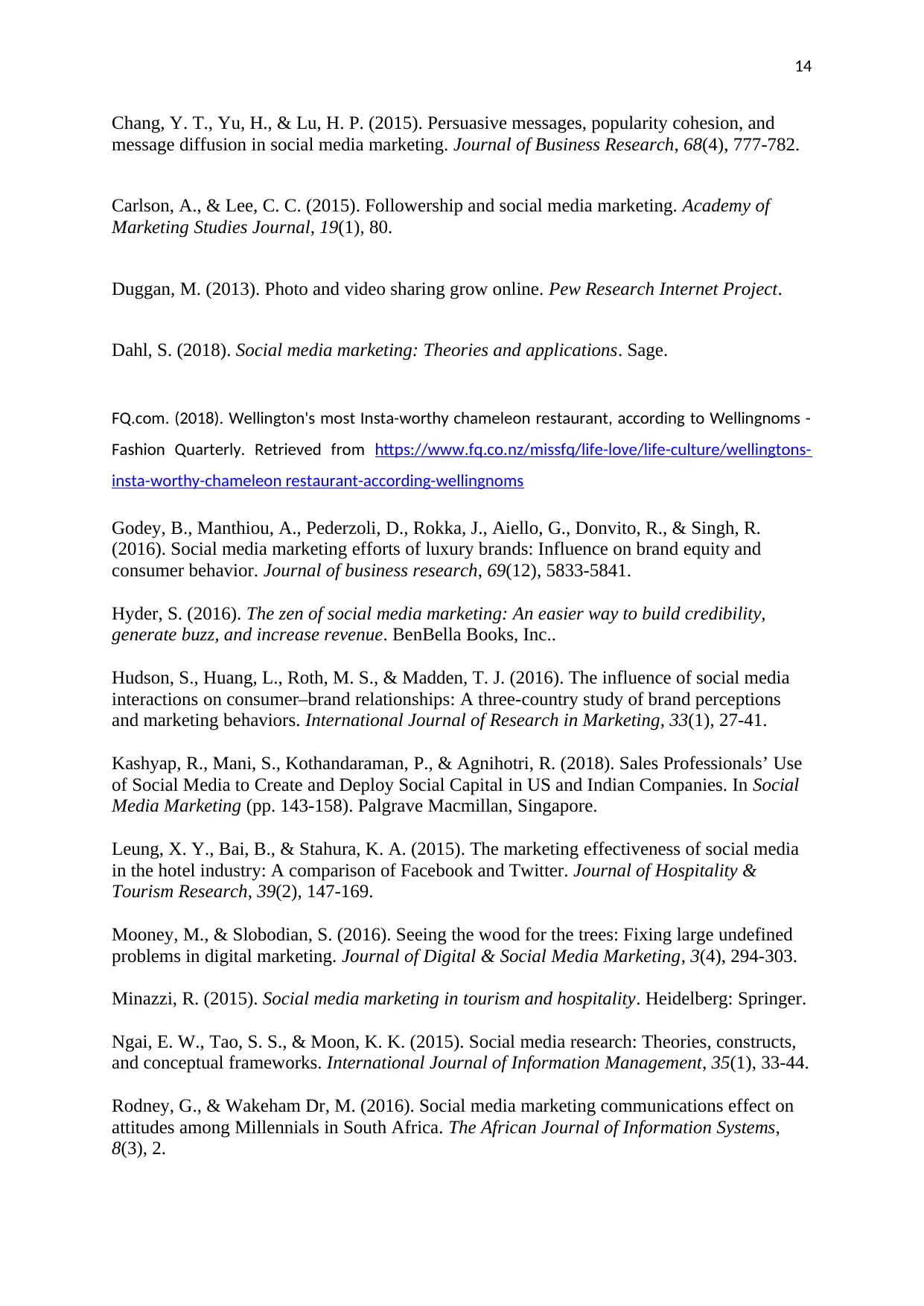
14
Chang, Y. T., Yu, H., & Lu, H. P. (2015). Persuasive messages, popularity cohesion, and
message diffusion in social media marketing. Journal of Business Research, 68(4), 777-782.
Carlson, A., & Lee, C. C. (2015). Followership and social media marketing. Academy of
Marketing Studies Journal, 19(1), 80.
Duggan, M. (2013). Photo and video sharing grow online. Pew Research Internet Project.
Dahl, S. (2018). Social media marketing: Theories and applications. Sage.
FQ.com. (2018). Wellington's most Insta-worthy chameleon restaurant, according to Wellingnoms -
Fashion Quarterly. Retrieved from https://www.fq.co.nz/missfq/life-love/life-culture/wellingtons-
insta-worthy-chameleon restaurant-according-wellingnoms
Godey, B., Manthiou, A., Pederzoli, D., Rokka, J., Aiello, G., Donvito, R., & Singh, R.
(2016). Social media marketing efforts of luxury brands: Influence on brand equity and
consumer behavior. Journal of business research, 69(12), 5833-5841.
Hyder, S. (2016). The zen of social media marketing: An easier way to build credibility,
generate buzz, and increase revenue. BenBella Books, Inc..
Hudson, S., Huang, L., Roth, M. S., & Madden, T. J. (2016). The influence of social media
interactions on consumer–brand relationships: A three-country study of brand perceptions
and marketing behaviors. International Journal of Research in Marketing, 33(1), 27-41.
Kashyap, R., Mani, S., Kothandaraman, P., & Agnihotri, R. (2018). Sales Professionals’ Use
of Social Media to Create and Deploy Social Capital in US and Indian Companies. In Social
Media Marketing (pp. 143-158). Palgrave Macmillan, Singapore.
Leung, X. Y., Bai, B., & Stahura, K. A. (2015). The marketing effectiveness of social media
in the hotel industry: A comparison of Facebook and Twitter. Journal of Hospitality &
Tourism Research, 39(2), 147-169.
Mooney, M., & Slobodian, S. (2016). Seeing the wood for the trees: Fixing large undefined
problems in digital marketing. Journal of Digital & Social Media Marketing, 3(4), 294-303.
Minazzi, R. (2015). Social media marketing in tourism and hospitality. Heidelberg: Springer.
Ngai, E. W., Tao, S. S., & Moon, K. K. (2015). Social media research: Theories, constructs,
and conceptual frameworks. International Journal of Information Management, 35(1), 33-44.
Rodney, G., & Wakeham Dr, M. (2016). Social media marketing communications effect on
attitudes among Millennials in South Africa. The African Journal of Information Systems,
8(3), 2.
Chang, Y. T., Yu, H., & Lu, H. P. (2015). Persuasive messages, popularity cohesion, and
message diffusion in social media marketing. Journal of Business Research, 68(4), 777-782.
Carlson, A., & Lee, C. C. (2015). Followership and social media marketing. Academy of
Marketing Studies Journal, 19(1), 80.
Duggan, M. (2013). Photo and video sharing grow online. Pew Research Internet Project.
Dahl, S. (2018). Social media marketing: Theories and applications. Sage.
FQ.com. (2018). Wellington's most Insta-worthy chameleon restaurant, according to Wellingnoms -
Fashion Quarterly. Retrieved from https://www.fq.co.nz/missfq/life-love/life-culture/wellingtons-
insta-worthy-chameleon restaurant-according-wellingnoms
Godey, B., Manthiou, A., Pederzoli, D., Rokka, J., Aiello, G., Donvito, R., & Singh, R.
(2016). Social media marketing efforts of luxury brands: Influence on brand equity and
consumer behavior. Journal of business research, 69(12), 5833-5841.
Hyder, S. (2016). The zen of social media marketing: An easier way to build credibility,
generate buzz, and increase revenue. BenBella Books, Inc..
Hudson, S., Huang, L., Roth, M. S., & Madden, T. J. (2016). The influence of social media
interactions on consumer–brand relationships: A three-country study of brand perceptions
and marketing behaviors. International Journal of Research in Marketing, 33(1), 27-41.
Kashyap, R., Mani, S., Kothandaraman, P., & Agnihotri, R. (2018). Sales Professionals’ Use
of Social Media to Create and Deploy Social Capital in US and Indian Companies. In Social
Media Marketing (pp. 143-158). Palgrave Macmillan, Singapore.
Leung, X. Y., Bai, B., & Stahura, K. A. (2015). The marketing effectiveness of social media
in the hotel industry: A comparison of Facebook and Twitter. Journal of Hospitality &
Tourism Research, 39(2), 147-169.
Mooney, M., & Slobodian, S. (2016). Seeing the wood for the trees: Fixing large undefined
problems in digital marketing. Journal of Digital & Social Media Marketing, 3(4), 294-303.
Minazzi, R. (2015). Social media marketing in tourism and hospitality. Heidelberg: Springer.
Ngai, E. W., Tao, S. S., & Moon, K. K. (2015). Social media research: Theories, constructs,
and conceptual frameworks. International Journal of Information Management, 35(1), 33-44.
Rodney, G., & Wakeham Dr, M. (2016). Social media marketing communications effect on
attitudes among Millennials in South Africa. The African Journal of Information Systems,
8(3), 2.
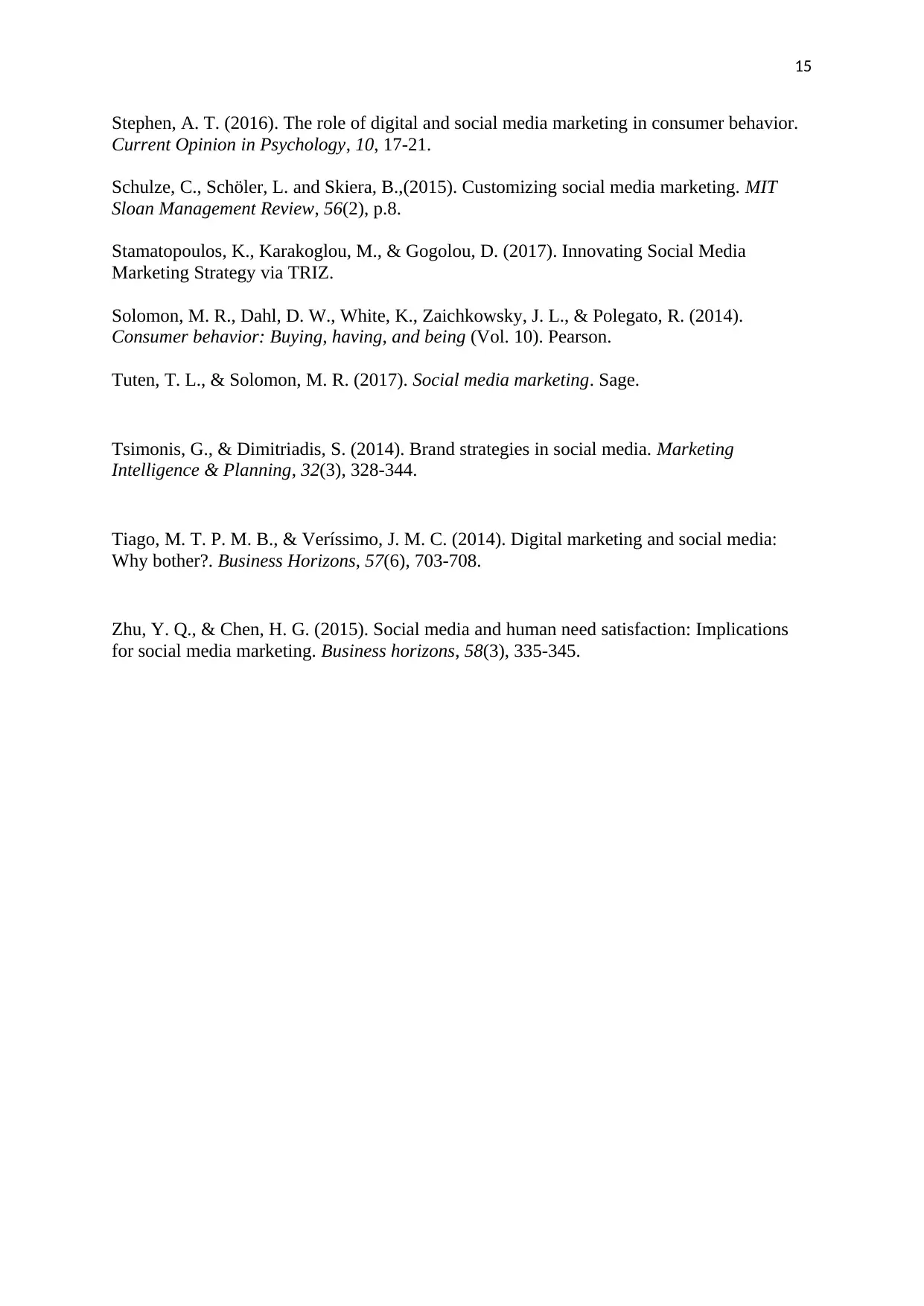
15
Stephen, A. T. (2016). The role of digital and social media marketing in consumer behavior.
Current Opinion in Psychology, 10, 17-21.
Schulze, C., Schöler, L. and Skiera, B.,(2015). Customizing social media marketing. MIT
Sloan Management Review, 56(2), p.8.
Stamatopoulos, K., Karakoglou, M., & Gogolou, D. (2017). Innovating Social Media
Marketing Strategy via TRIZ.
Solomon, M. R., Dahl, D. W., White, K., Zaichkowsky, J. L., & Polegato, R. (2014).
Consumer behavior: Buying, having, and being (Vol. 10). Pearson.
Tuten, T. L., & Solomon, M. R. (2017). Social media marketing. Sage.
Tsimonis, G., & Dimitriadis, S. (2014). Brand strategies in social media. Marketing
Intelligence & Planning, 32(3), 328-344.
Tiago, M. T. P. M. B., & Veríssimo, J. M. C. (2014). Digital marketing and social media:
Why bother?. Business Horizons, 57(6), 703-708.
Zhu, Y. Q., & Chen, H. G. (2015). Social media and human need satisfaction: Implications
for social media marketing. Business horizons, 58(3), 335-345.
Stephen, A. T. (2016). The role of digital and social media marketing in consumer behavior.
Current Opinion in Psychology, 10, 17-21.
Schulze, C., Schöler, L. and Skiera, B.,(2015). Customizing social media marketing. MIT
Sloan Management Review, 56(2), p.8.
Stamatopoulos, K., Karakoglou, M., & Gogolou, D. (2017). Innovating Social Media
Marketing Strategy via TRIZ.
Solomon, M. R., Dahl, D. W., White, K., Zaichkowsky, J. L., & Polegato, R. (2014).
Consumer behavior: Buying, having, and being (Vol. 10). Pearson.
Tuten, T. L., & Solomon, M. R. (2017). Social media marketing. Sage.
Tsimonis, G., & Dimitriadis, S. (2014). Brand strategies in social media. Marketing
Intelligence & Planning, 32(3), 328-344.
Tiago, M. T. P. M. B., & Veríssimo, J. M. C. (2014). Digital marketing and social media:
Why bother?. Business Horizons, 57(6), 703-708.
Zhu, Y. Q., & Chen, H. G. (2015). Social media and human need satisfaction: Implications
for social media marketing. Business horizons, 58(3), 335-345.
1 out of 15
Related Documents
Your All-in-One AI-Powered Toolkit for Academic Success.
+13062052269
info@desklib.com
Available 24*7 on WhatsApp / Email
![[object Object]](/_next/static/media/star-bottom.7253800d.svg)
Unlock your academic potential
© 2024 | Zucol Services PVT LTD | All rights reserved.





